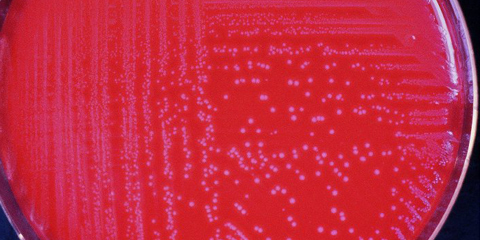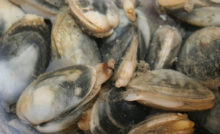Listeria monocytogenes


Definition
Listeria monocytogenes is a bacterium responsible for listeriosis, infectious disease rare but serious. It is the only species in the genus Listeria pathogenic for humans.
Symptoms
The bacteria ingested in food any can cross the intestinal wall and cause various symptoms such a seemingly benign flu condition, among women pregnant.
The symptoms are most important :
- In the fetus and the baby (neonatal meningitis including, or miscarriage, or even Wegener infantiseptica resulting from transplacental contamination allowed by two proteins of Listeria (called InlA and InlB) which pair to receptors which are respectively the E-cadherin and updates, allowing the bacteria from sticking to the placenta and then to cross. Pre-natal meningitis cases would be, According to Seeliger, due to the presence of Listeria in the vaginal flora of the mother. It seems, however, that this vaginal commensalism has been detected only in Germany.
- Adults or young immunocompromised, It is likely that it identifies that the tip of the iceberg whose base is constituted by undetected infections, the germ bit pathogenic for the normal man. The epidemiology is poorly known : a Memorial animal contact lack in a good half of the cases.
Sensitivity
Listeria monocytogenes does not survive more than 30 minutes to + 60 ° C. Pasteurization eliminates it food. But at temperatures of refrigeration, She continues to develop unlike most other bacteria, What is a selection criterion. It resists several months in soil. It was destroyed at a pH below 4. This psychrophile germ is sensitive to most disinfectants : aldehydes, chlorinated derivatives, media and the quaternary ammonium compounds in the normal conditions of use. It is even more resistant to temperature is low and the porous surface.
Epidemiology
The incubation period can last for 2 to 70 days after ingestion of the food, What bothers the retrospective research of the food in question during a clinical episode.
Infections are isolated or can be grouped in time and it is considered an outbreak of listeriosis. In this case, the monitoring system set up in France seeks to identify the food in question, allowing to show responsibility for the industrial pork (Rillettes and jellied pork tongue) and some cheese in recent epidemics.
« Listeriosis is a rare disease, whose frequency was decreased threefold since 1987 ; There has been 661 then identified in case 458 in 1992 and 228 in 1997 », According to Anne-Claudia Marie, Assistant Director of food hygiene in the Food Branch (EB). « This steady decline is due to the efforts of the professionals, under the aegis of control services, including through the use of generalized HACCP methods (Hazard analysis and critical control points), for the control of the Listeria risk. Industrialists have made gigantic efforts, but zero risk does not exist. Today, We are at a threshold where the efforts towards raw materials must be accompanied by appropriate information, including medical, which will allow to reduce the number of cases. »
Source :
Additional information :
Download : Characteristics and Sources of Listeria Monocytogenes par l’HANDLES.
Recent Posts
Cakes, Candy : Warning on nanoparticles
100 % tested products contained nanoparticles ! [...] Les résultats de cette expérience ont…
How to eliminate toxins ?
After a series of festive meals, caloric menus, alcoholic or carbonated drinks,…
Plastic, not so fantastic!
Plastic pollutes the environment, we all know it. Il faut aussi rappeler que les objets…
How to eat healthy during lunch break ?
At work, lunch breaks are often done on the go, en quelques minutes et…
Eat healthy, it's really possible ?
These last years, le bio et le sain se sont imposés avec insistance dans nos…
Sausages and merguez salmonella
The company L’Atelier du Valois has recalled batches of "Plateau variegated" suite…


View Comments